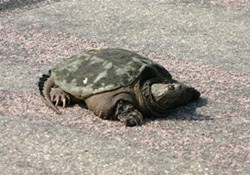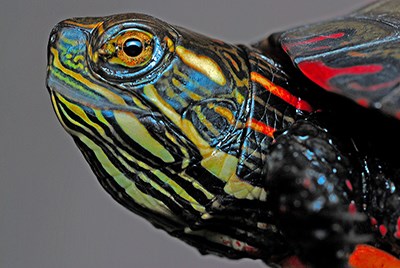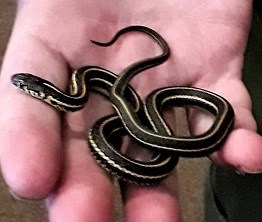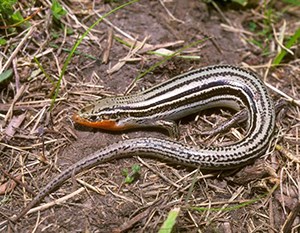|
Only a few species of reptiles occur within Pipestone National Monument. Turtles enjoy the waters of Pipestone Creek while garter snakes and skinks prefer the Sioux quartzite prairie. The following reptiles have been recorded within Pipestone National Monument: 
NPS/G. Wagner Size: The shell can grow to 20" long, though 9-18" is typical. They weigh ~20-30 lbs. Appearance: The shell, or carapace, is dark brown or black. The tail has sharp ridges and is almost as long as the shell. Their mouth is a strong beak, their skin is covered in bumps (tubercles), and their feet are webbed claws. Lifespan: 30-40 years Diet: Aquatic plants, small mammals, fish, insects, and anything else they can catch! Are they really aggressive? They can be, but that reputation is really only fair during breeding season or when they're on land and vulnerable (which is rare!). In the water, they are more likely to swim away from any disturbances caused by humans. 
Public Domain/www.goodfreephotos.com Size: 4-10" long (the largest of the 4 painted turtle species) Appearance: The top of the oval, smooth shell is olive or black. The lower edge of the shell is what gives this aquatic turtle its name - it's red with yellowish patterns. The have yellow lines running down their neck and their feet are webbed. Lifespan: They can live as long as 20 years Diet: They're omnivores! In addition to plants, insects, and small animals, these turtles will act as scavengers, cleaning up decay from fresh water sources. Nature's Sunbathers: Being cold-blooded, western painted turtles take to basking on logs and rocks to get as much heat from the sun as possible. They'll even crawl on top of each other to try and get the best spot for sunning. 
NPS/N. Barber Size: ~2-3' on average Appearance: Black or dark brown with a yellow-orange stripe down its back and yellow lateral stripes on each side. There are often yellow spots on its head. Lifespan: ~10 years Diet: Rodents, slugs, worms, and aquatic animals when near water "Are they poisonous?" This is a common question when seeing a snake, but garter snakes are harmless to humans. An impressive buddy-system: Cold-weather garter snakes will huddle in dens as a group - and they travel long distance to do so. One den in Manitoba boasts over 50,000 red-sided garter snakes each winter. 
Photo by MDC Staff, courtesy Missouri Department of Conservation Size: 5-8" long Appearance: Gray or olive-brown color with dark and light stripes running the length of the body. As juveniles, their tails are bright blue, but the color fades as they mature. Males will develop bright orange coloring on their throat and jaws during breeding season. Lifespan: Upwards of 7 years Diet: Crickets, grasshoppers, snails, and spiders Their Great Escape: Skinks are able to detach their tails in order to evade predators and grow a new one later. |
Last updated: April 29, 2019
